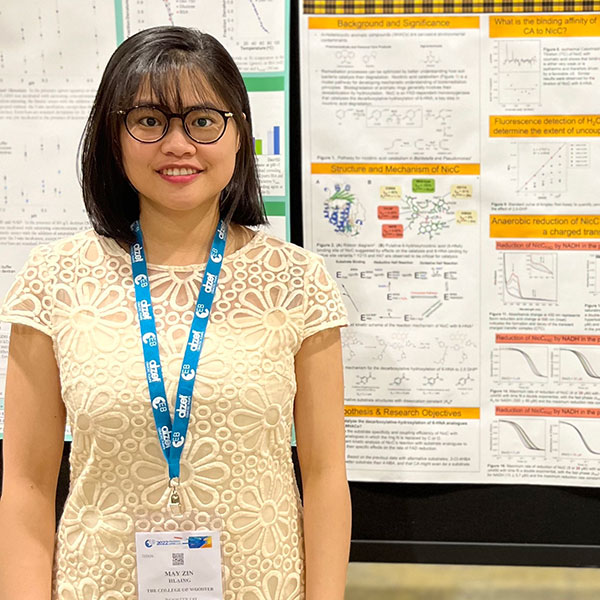
Investigating Substrate Specificity for 6-Hydroxynicotinate 3- Monooxygenase (NicC) with Alternative Substrates: Consequences to Catalysis of Replacing the Ring Nitrogen

Name: May Zin Hlaing
Major: Biochemistry and Molecular Biology
Advisor: Dr. Mark Snider; Dr. Dean Fraga (second reader)
6-Hydroxynicotinate 3-monooxygenase (NicC) is a group A flavin dependent monooxygenase (FDM) that catalyzes the regioselective decarboxylative hydroxylation of 6-HNA into 2,5-dihydroxypyridine (DHP) with the concomitant oxidation of NADH to NAD+. This enzyme-catalyzed reaction involves three segments: (1) substrate binding, (2) FAD reduction by NADH, and (3) hydroxylation-decarboxylation of 6-HNA through a hydroperoxy-flavin intermediate. Past studies have shown that NicC can catalyze this reaction with alternate aromatic substrates including 4-hydroxybenzoic acid (4-HBA), a substrate analogue with a homocyclic ring (i.e. lacking the ring nitrogen). However, 4-HBA is bound weakly (360 Å} 66 μM) and only 50% of the reaction progresses to substrate hydroxylation, versus hydroperoxy-flavin degradation to H2O2, suggesting the importance of the ring nitrogen in the coupling efficiency of NicC. To further explore the role of the ring nitrogen, the efficiency and specificity of the reaction with coumalic acid (CA) was determined. Binding of CA by NicC is an isothermal process (ΔH = 0), indicating that it is driven by a favorable change in entropy. Analysis of the reaction products by Q-TOF MS indicates that NicC catalyzes the decarboxylative hydroxylation of CA into 5 hydroxy-2Hpyrane-2-one. However, coupling experiments by HPLC analysis and detection of H2O2 by a fluorescence assay both indicate that the reaction with CA is highly uncoupled with only minor 5-hydroxy-2H-pyrane-2-one formation. Transient state kinetic analyses by stopped flow under anaerobic conditions to permit single-turnover kinetics shows that, CA bound to NicC enhances its rate of NADH oxidation 37-fold (by comparison, 6-HNA enhances the rate of NicC NADH oxidation 46-fold). These results indicate that an Hbond accepting group in the aromatic ring at position 1 is important for establishing the correct conformation of the ES complex to enable effective binding, flavin reduction and, ultimately, substrate hydroxylation. Steady state kinetic indicate that NicC-CA equilibrium dissociation constant is higher than previously reported (i.e CA have loose binding to NicC). Determination of the microscopic rate constants from transient kinetic analyses of the reduction half reactions of NicC with CA, 4-HBA and 3-Cl-4HBA, and the steady state kinetic analysis of 3-Cl-4HBA are reported in this research.
 Loading...
Loading...
Posted in Comments Enabled, Independent Study, Symposium 2022 on April 26, 2022.
4 responses to “Investigating Substrate Specificity for 6-Hydroxynicotinate 3- Monooxygenase (NicC) with Alternative Substrates: Consequences to Catalysis of Replacing the Ring Nitrogen”
Related Posts
Related Areas of Study
Biochemistry & Molecular Biology
Biology and Chemistry combine in an interdisciplinary program for students with a passion for molecular events.
Major


It is so fun to see your research, May! Thanks for sharing your impressive work.
Thank you so much Dr. Krause!!!
Congratulations on your I.S., May! It’s cool to see how the mass spec results fit into your broader project findings.
Congratulations, May! I enjoyed talking with you about your project.